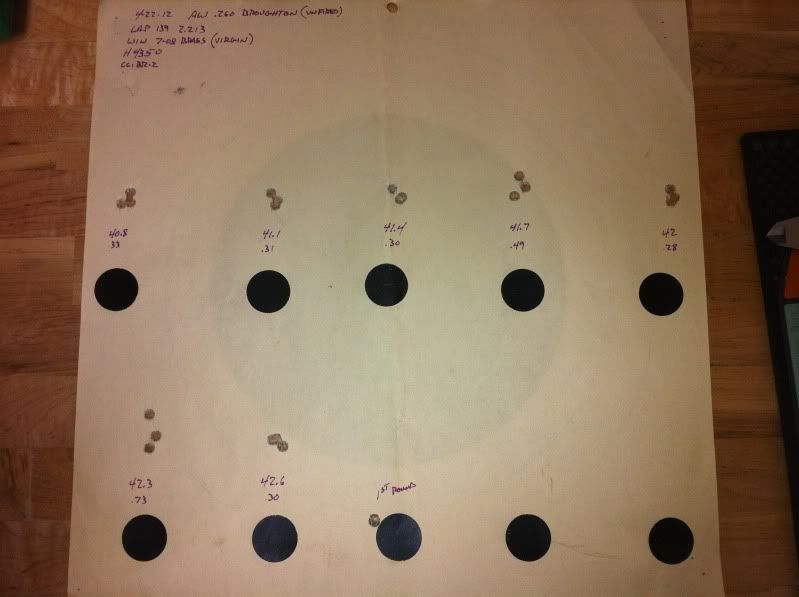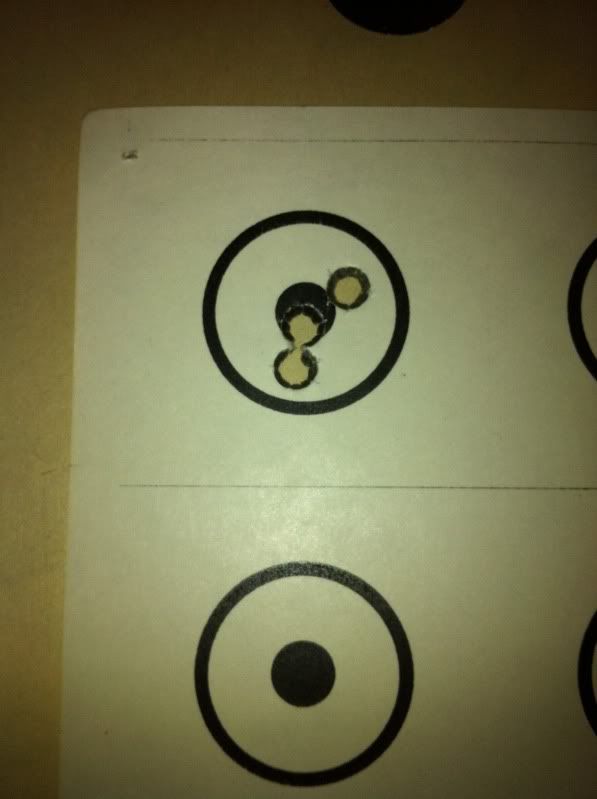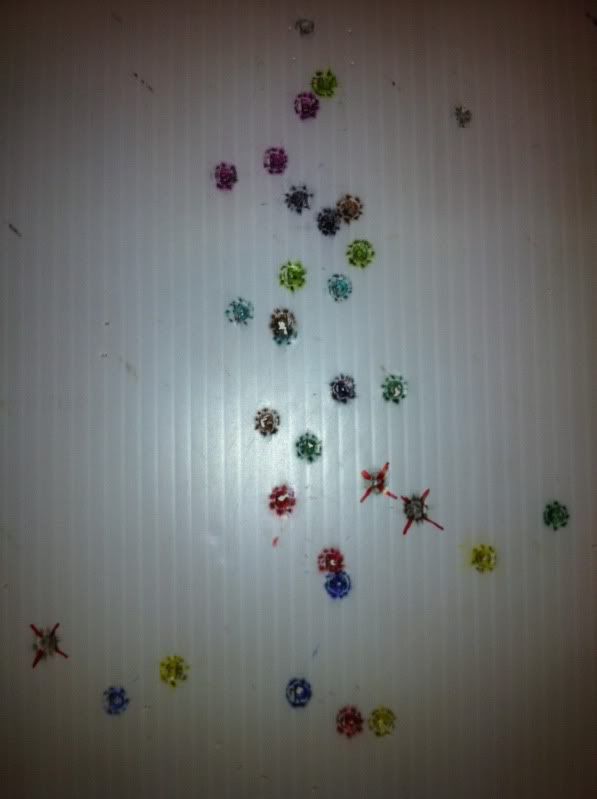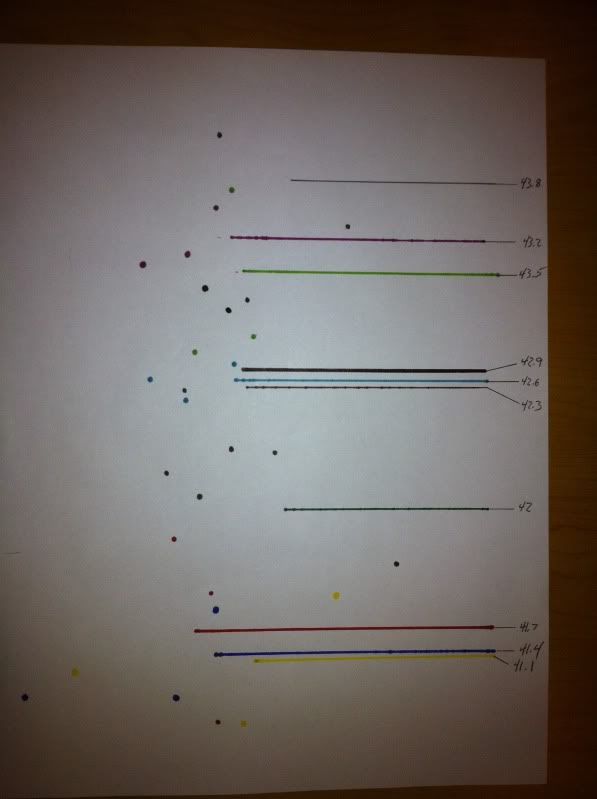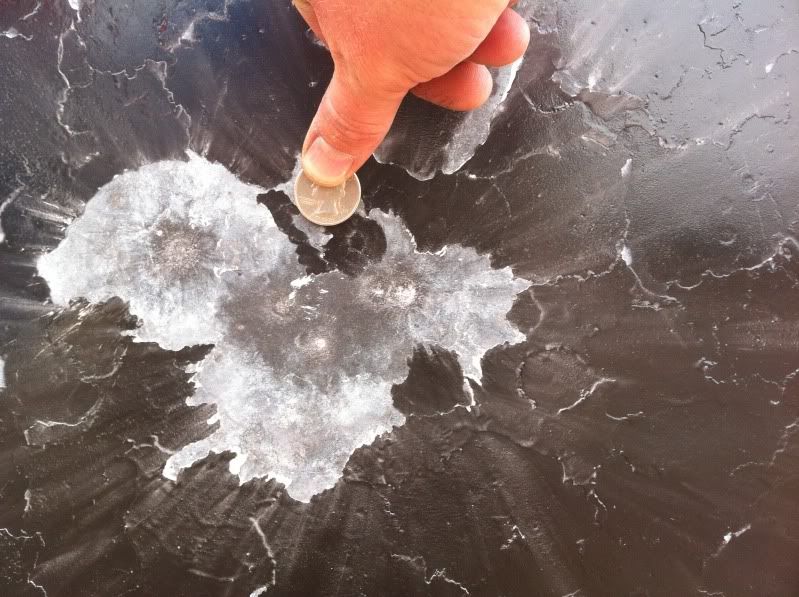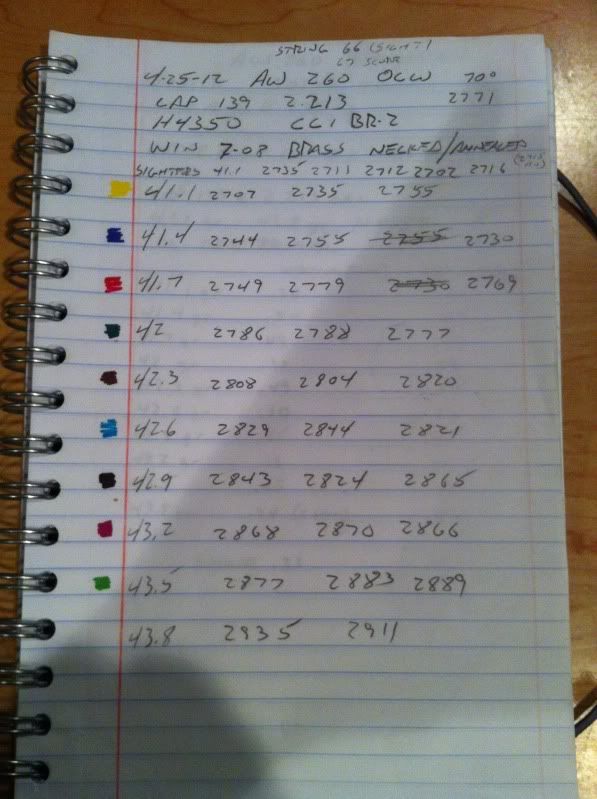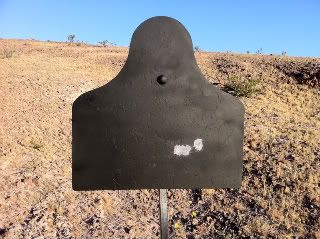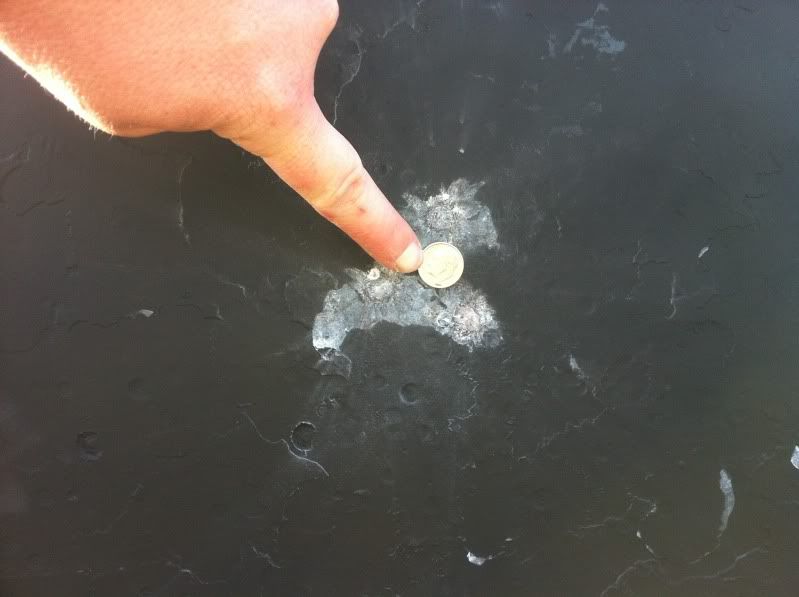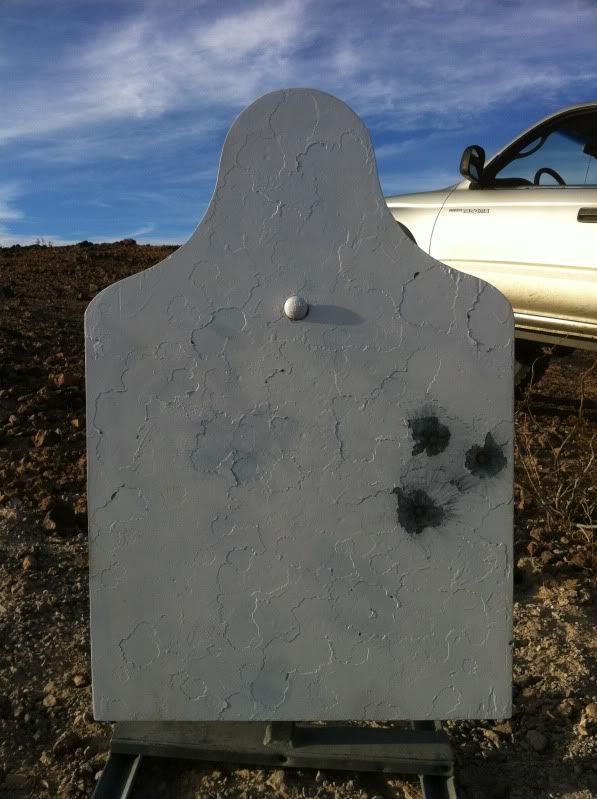Re: OCW test from a new and unfired barrel
I went camping in the desert for the last two days. It was hot as hell Tues, but wed's forecast was better so I decided to shoot the test this morning. If you have access to a cold beverage, go get it.
The target was placed at 500 yards. It actually ranged 498-501 yards using my swaro laserguide. I had two full size "echo" steel targets set a few inches to the side of my target frame, which made an easy target for the rangefinder. I use the steel to zero the starting charge weight to a point of impact slightly above my point of aim, and centered.
I used loads from 41.1-43.8 grains, in .3 grain increments. The rest of the load was the same as before with the exception of a higher and wider range of charges. I colored each load with a different color sharpie(ogives only). The highest load was left naked because I was out of colors. Also note there are only two shots at this charge (43.8). I didn't fire the last round because the last round at 43.5 gr showed signs of pressure and I didn't want to continue.
It was about 70 degrees and overcast, and the only mirage came late in the string. The barrel never got hot due to the slow tempo, but I could see mirage in the scope.
Here is the target. The black box was drawn for use as an aiming point. The actual target is poster board with very faint grid lines. The colors don't show very well here in the pic, see below.
A caliper for scale.
This is the backer. It is corrugated plastic, and shows the colors much more vividly. Since this was a previously used backer, I put a red X over a few previous holes. Note the two top holes have no color as the bullets were naked.
Once I got home I taped an 8.5X11 sheet of paper to the back of the target so the target could be used to plot out the impacts. I did this because I didn't want to screw up the target in case I made a mistake. It is difficult to see but the dot and line color corresponds to the color of the bullet that made the holes in the original target. Where the line terminates inside each group is more or less arbitrary, some are in the respective group, and some just in the middle of the entire blob of holes. The lines represent the height of the center of the each group, for easy comparison to the others. At the end of each line is the charge weight.
Normally I wouldn't do this much work, but this is a very graphic example of the vertical dispersion associated with an OCW test done at long range. That vertical is far less than most people realize, generally speaking.
Every shot was fired over a chrono, and that data was recorded on a pad in between rounds to keep the tempo down. A friend of mine, who was seated at my feet, said there was a minute to a minute and a half between shots. The string was shot prone, with a redman bag, but from a different bipod than last time. This one is a harris but has big three toe claws at the end. I can't remember the name of vendor, but the owner is on the hide (Cheese maybe?). The ground in the desert is volcanic rock and dirt, and these feet bite in but don't tend to burrow deeper with each shot, as a harris foot does.
This takes a shit load of concentration! Shooting 29 rounds with precision for nearly 45 minutes, is no joke. When I do this I don't lift my cheek off the rifle, not once. After firing, I eject the case, stick it back into the loading block where it came from, glance at the chrono, record the number, and top feed the mag through the e-port(love them AW's) with the next round for the shot. Mentally draining, and at 30 minutes or so my cheek starts to ache.
I use a S&B 4-16 with a standard mildot. I could see the a blob forming by the time I was halfway through the string, but I could not follow any single shot. This is part of what keeps me focused, and really is the beauty of this method. I can't see a bad shot if there is one. It is like a dry fire session, with loading/unloading, and recoil. It's easy to mindf%$k yourself when you throw a shot, because you will subconsciously steer the next round, instead of letting it go and starting over. We all like to say we do that, but it is freakin hard, at least for me! If you have poor concentration skills, you will find my method hard, or have bad results, plain and simple. In fact, 30 rounds is more than I fire in any one session, and I shoot about twice a week most weeks.
On to some analysis. Just a quick look at the plotted target with the horizontal lines (4th photo) shows you that large spreads of charge weight stack on top of each other, literally. This is where I have a disagreement with Trip. Were I to fill in the gaps with .1 intervals, this becomes very busy and hard to interpret. Am I supposed to believe that there are four more groups I should be firing, 12 more rounds, INSIDE each of these nodes? I understand that if you desire, the spread of charges can be focused down to just outside either end of the node, IF you knew where the node was. Even if you think you know where it might be, you either shoot a lot of rounds, or miss one end or the other. This string took almost 45 minutes of serious concentration, I don't have it in me to go much longer.
To put the above into perspective, check this out. That lower node has a center to center extreme vertical spread of .07 MOA...yes, that decimal is in the right place. The middle node, is .04 MOA! The top node, where recoil was becoming substantial compared to the lower charges, is .25 MOA! Some of you may be saying "So what, who cares where the center is if the group is huge". Well, the center is the key, but the groups were small. If you want numbers, keep reading please.
Lets spin those around another way by combining the groups together for each node. Each of these nodes, as you can see, has a spread of .6 grains. Even if the node edges vary a tick outside or inside, we are talking about ONE QUARTER MOA at the very worst here! What possible good could it do to add more intervals. Can anybody here shoot inside that? Can you shoot inside a .04-.25 MOA vertical spread at 500 yards...I mean enough to test and gain data? With a show of hands, how many of you would like to shoot .25 MOA vertical with your loads at 500 yards (everybody's hands should be up). I am not challenging anyone, or bragging, I am simply speaking of practical field accuracy. How does one sit down, or lay, and discern .1gr? I'm pretty sure my extreme spreads, which are normally in the teens, can absorb .1 grains. Sure, with enough data points, you'll see the trend. Practical field accuracy, not benchrest.
Looked at another way:
The lower node group size (all three groups)is .49 MOA tall, and .85 MOA wide, and encompasses a 72 fps extreme spread. 9 rounds into half MOA. Respectable anywhere, crazy considering the charge window size and round robin routine!
The middle node group size is .52 MOA tall, and .22 MOA wide, and encompasses a 62fps extreme spread.
The upper node group size is .6 MOA tall, and .57 MOA wide, and encompasses a 69 fps extreme spread.
Hurrah for barrel harmonics! No care whatsoever was taken to shoot in any specific wind condition. That would have taken far too long, and would have ignored the loose tempo I can keep with the firing cycle. This way barrel heat increases progressively across all rounds fired, as best I can control, while shooting well.
Here are some other stats:
The mean average vertical dispersion for each individual charge weight was .33 MOA(all ten loads). The small group was 42.6 gr at .1 MOA, followed closely by 43.2 gr at .16 MOA. Large group was .49 MOA (two actually 41.7, and 42.3)
The average group size for each load(all of them), measured center to center, was .47 MOA. Small group was from 42.6 gr at .23 MOA, followed closely by 43.2 at .25 MOA. Large group was 41.1 at .74 MOA which was all horizontal because it was only .36 MOA tall.
These would be very good results if one was firing three shot groups of different loads individually, as is traditionally done by the reloader. This is exceptional when you consider the variables involved in firing this many loads, over this much time, in a round robin fashion. Aside from some of the velocity thresholds, I haven't looked into the velocities at all.
My initial post was not for the purpose of bragging, although re-reading that post, it does come across a little snide. I apologize. I understand that lots here on the hide are on-board with cleaning and break-in, or should I say the lack of it, but there are still lots of you that aren't! Trip, you know this. I wasn't speaking directly at you. Except for LL, I can't remember the last time someone posted what I did to include accuracy and cleaning. Maybe it happened yesterday and I missed it, I don't know. I took the opportunity to do it in front of people, and take some pics.
Charge weights:
People here obsess over this, along with every other element of their loads. I'm not talking about testing, I'm talking about day to day loading. You are worse off for this. If you need this to feel good about your ammo or shooting, you should shift your focus IMO. I am also not talking about ELR shooting...If a target was beyond about 1350 yards, I've never dropped the hammer on it.
Dan Newberry:
I have never met him, or even exchanged an email with him (that I can recall anyway). The guy deserves some serious credit. Putting a methodology together that absolutely revolutionized load development, and giving it a name. My execution is different than his, but the results are interpreted exactly the same.
Trip, you and I are just gonna have to agree to disagree. You can call my method a giraffe if you want, or a parrot because it is colorful, but I think it adheres to Dan's method pretty well. In fact this exact method links out of his site somewhere, although I cannot find it right now. It may be an indirect link, but his site is how I got there. I will continue to call it OCW. You may think I'm clueless, but my targets are not lying to me. These experiences, as I have said, have been repeated many times before. While today's results are exceptional, they are in-line with with a dozen or so other rifles.
Reading through Dan's site, the only concrete difference I can find is he prefers individual bulls, and 100 yards. The principles are all here though.
On a slightly random note, I have a custom .17 fireball which I shoot 20 gr V-maxes in. I did this same test at 400 yards...even the gunsmith laughed at me. Believe it or not, I used .3 grain increments. Results were excellent, and I still have the target to prove it. I'm not a die hard .3 grain increment guy, use what you want. With a .308 size case, .3 falls right in with Dan's instructions and examples.
conclusion:
I still have some work to do. Dan recommends loading up a few in the center of the node, and two more sets of loads in .1 grain increments on either side of it. That makes perfect sense, and I'll be doing that.
Just glancing over the velocities, they are very promising. If you are curious, the highest velocity was 2935, and the average for the 42.6 gr load (middle of the middle node)was approximately 2830 fps.
I do not agree with doing an OCW at 100 yards, plain and simple. For me, I showed I can do it in my first post, but doing it this way is like holding a magnifying glass up to the results. I also don't recommend you go out and do it at 500 unless you know yourself to be consistent. An intermediate range can work just as well, perhaps 300 yards. No reason you couldn't use multiple bulls either, I like my way because the shot setup is consistent. I have one bull to aim at the entire test.
I also shot 5 rounds of 130 jlk VLD's while in the desert and believe it or not, the group was a stunner, and may shoot better than the 139's. I was even jumping them .020. That's not unusual for this batch of JLKs (I have a few thousand), but it is a little weird for VLD's.
Today I was able establish several clear nodes. One of them is not viable(upper), due to pressure. I don't want to operate that close to the limit. I want ammo that works. Whether I leave it in the car on a sunny day, or in direct sunlight, I will not except anything but 24/7 365 functioning ammo. I also established today that the entire range of charges shoots accurately at long range. I have shot nearly 4000 139's so I know they work, but relying on a 100 yard test would require a longer range test at some point.
For me, this method just works. The results are interesting, and they leave little to guess about.
Monkey wrench! Random load using the 130 JLK's at 500 yards. 5 rounds, and no attempt to shoot around conditions.
Dan Newberry's site:
http://optimalchargeweight.embarqspace.com/
